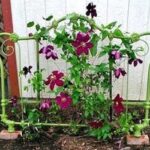Designs for vegetable garden layouts play a crucial role in the success of your gardening endeavors. The layout of your vegetable garden determines not only the aesthetic appeal but also its functionality and productivity. Whether you are a traditional gardener, an advocate for modern designs, or limited on space, there are various options to consider when planning your vegetable garden layout.
When it comes to creating a well-designed vegetable garden layout, there are several key factors to take into consideration. From the type of vegetables you plan to grow to the available space and environmental conditions, each aspect plays a vital role in determining the most suitable layout for your needs. By understanding these key factors, you can effectively design a vegetable garden that is both visually pleasing and productive.
In this article, we will explore different designs for vegetable garden layouts, ranging from traditional to modern and innovative options. We will also delve into maximizing space with small vegetable garden layout designs and the concept of vertical gardening.
Additionally, we will discuss companion planting as a method for increasing yield and provide tips for maintaining your vegetable garden layout. Whether you are new to gardening or looking to revamp your existing layout, understanding the importance of a well-designed vegetable garden layout is essential for creating a thriving and beautiful garden space.
Key Factors to Consider When Designing a Vegetable Garden Layout
When designing a vegetable garden layout, there are several key factors to consider in order to ensure a successful and productive garden. Whether you are a beginner or experienced gardener, taking these factors into account will help you create a well-organized and efficient space for growing your favorite vegetables.
Location and Sunlight
One of the most important factors to consider when designing a vegetable garden layout is the location and sunlight exposure. Most vegetables thrive in full sun, so it’s crucial to choose a spot that receives at least 6-8 hours of direct sunlight per day.
Take note of any obstructions such as trees or buildings that may block sunlight, as this can affect the growth of your plants. Additionally, make sure the location has easy access to water for irrigation purposes.
Soil Quality and Drainage
Another essential factor to consider is the quality of the soil and its drainage capabilities. Conduct a soil test to determine its pH level and nutrient content, and make any necessary amendments to ensure it is suitable for growing vegetables. Good drainage is also important to prevent waterlogging, which can lead to root rot and other issues. Raised beds can be a great solution for improving drainage in areas with heavy clay soil.
Planting Space and Accessibility
Consider the space needed for each type of vegetable you plan to grow, as well as their compatibility with one another. Some plants require more room to spread out, while others can be planted closer together. Plan your layout accordingly to maximize growing space without overcrowding your plants. Additionally, think about accessibility within the garden – leave enough room between rows for walking and tending to your plants without damaging them.
Taking these key factors into consideration when designing your vegetable garden layout will set you up for success and help you create an efficient and bountiful garden space. By carefully planning the location, soil quality, planting space, and accessibility of your garden, you can ensure that your vegetables have the best possible environment in which to thrive.
Traditional Vegetable Garden Layout Designs
When it comes to traditional vegetable garden layout designs, many people prefer the classic approach that has been used for generations. One of the most common layouts is the row planting method, where vegetables are planted in long, straight rows with pathways in between. This layout makes it easy to access and maintain the garden, as well as providing ample space for each type of vegetable to spread out and grow.
Another traditional design is the square foot gardening method, which involves dividing the garden into small square plots and planting different vegetables in each plot. This type of layout is great for maximizing space and is ideal for beginners or those with limited garden space. It also helps with proper spacing and organization of plants.
For those interested in a more organized and aesthetic approach, the kitchen garden design offers a traditional yet stylish option. These gardens typically incorporate geometric shapes and feature neat, symmetrical patterns of vegetables and herbs. The result is not only a functional garden but also an attractive addition to any landscape.
Overall, traditional vegetable garden layout designs provide tried-and-true methods that have proven successful over time. Whether you prefer straight rows, small plots or a more decorative approach, there are plenty of options to choose from when designing your vegetable garden.
Modern and Innovative Vegetable Garden Layout Designs
When designing a vegetable garden layout, there are many modern and innovative designs to consider that can maximize space and yield. Some popular modern and innovative vegetable garden layout designs include:
- Container Gardening: Utilizing containers to grow vegetables is a modern and space-saving design. It’s perfect for urban gardens or small spaces.
- Keyhole Gardens: This unique circular design allows easy access to the entire garden bed while also incorporating a composting system in the center.
- Hydroponic Systems: Hydroponic gardening uses nutrient-rich water instead of soil, making it an innovative and efficient way to grow vegetables indoors or in limited outdoor space.
In addition to these designs, incorporating sustainable practices like rainwater harvesting, using recycled materials for garden beds, and integrating smart irrigation systems can also be considered modern and innovative approaches to vegetable garden layout designs.
Implementing modern technology such as garden planning apps or using 3D modeling software can also help visualize and plan out the vegetable garden layout effectively.
It’s important to stay updated on modern gardening techniques and innovations in order to create an efficient and productive vegetable garden layout that suits your needs. By embracing these modern and innovative designs, you can make the most of your gardening experience while keeping up with the latest trends in sustainable and efficient growing practices.
Maximizing Space
When it comes to small vegetable garden layout designs, maximizing space is key. With limited area, it is important to make the most of every inch of your garden. One popular approach to small vegetable garden layouts is square foot gardening, which involves dividing the garden into small square sections and planting different crops in each section.
Vertical gardening is also an effective way to maximize space in a small vegetable garden layout. By using trellises, stakes, or hanging planters, you can grow climbing vegetables such as tomatoes, cucumbers, and beans upwards rather than outwards. This not only saves valuable ground space but also makes for a visually appealing garden.
Another strategy for maximizing space in a small vegetable garden layout is intercropping, which involves planting quick-growing crops between slower-growing ones. For example, radishes can be planted between rows of carrots or lettuce to make use of the soil while the other plants are still growing.
It’s important for those with limited space for gardening to carefully plan and utilize every square foot effectively. With the right design and techniques, even small yards or urban spaces can yield a bountiful harvest of fresh vegetables.
| Maximizing Space Techniques | Examples |
|---|---|
| Square Foot Gardening | Dividing the garden into small square sections for different crops |
| Vertical Gardening | Growing climbing vegetables upwards with trellises or hanging planters |
| Intercropping | Planting quick-growing crops between slower-growing ones to maximize land usage |
Vertical Vegetable Garden Layout Designs
Vertical gardening has become increasingly popular in recent years, especially for those with limited space. This innovative approach to vegetable garden layouts involves growing plants upwards instead of outwards, making it perfect for small yards, balconies, or even indoor spaces. By utilizing trellises, hanging baskets, and vertical planters, gardeners can maximize their growing area and achieve an abundant harvest in a compact space.
One of the key benefits of vertical vegetable garden layout designs is the efficient use of space. Instead of needing a large plot of land for traditional gardening, vertical gardens allow you to grow a variety of vegetables in a smaller area. This not only makes gardening more accessible to those with limited outdoor space but also promotes sustainability by using resources efficiently. Additionally, vertical gardens can create a visually stunning display that adds beauty and greenery to any environment.
When designing a vertical vegetable garden layout, it’s important to consider the specific needs of the plants you intend to grow. Some vegetables thrive in vertical environments, while others may require more horizontal space to spread out.
Factors such as sunlight exposure, watering needs, and support structures should be carefully planned to ensure the success of your vertical garden. With careful consideration and creative design, a vertical vegetable garden layout can provide bountiful harvests and an attractive addition to any home or landscape.
Companion Planting
One common example of companion planting is the Three Sisters method, which involves planting corn, beans, and squash together. Corn provides support for the beans to climb, beans fix nitrogen in the soil to benefit all three plants, and squash acts as ground cover to suppress weeds and retain moisture. This symbiotic relationship among the three crops not only maximizes space but also enhances their individual growth.
Another important aspect of companion planting is understanding which plants complement each other and which ones should be kept apart. For instance, planting basil next to tomatoes can improve the flavor of the tomatoes while deterring pests, but tomatoes should be kept away from potatoes as they are susceptible to similar diseases. Researching plant compatibility and implementing thoughtful pairings can lead to a more harmonious and productive vegetable garden layout.
In addition to enhancing plant growth and yield, companion planting also promotes biodiversity within the garden ecosystem. By incorporating various species that work well together, you can create a more resilient and balanced environment that supports beneficial insects and microorganisms. This holistic approach to designing a vegetable garden layout not only benefits your crops but also contributes to the overall health of your garden.
Garden Maintenance
When it comes to maintaining a vegetable garden layout, there are several important tips to keep in mind to ensure that your garden continues to look great and thrive. One of the key aspects of garden maintenance is regular watering. It’s important to water your vegetable garden consistently, making sure that the soil remains moist but not waterlogged. Consider investing in a drip irrigation system or soaker hoses to make this task more efficient.
In addition to watering, regular weeding is essential for maintaining the appearance and health of your vegetable garden layout. Weeds compete with your vegetables for nutrients and can quickly overtake your garden if left unchecked. Set aside time each week to thoroughly inspect your garden for weeds and remove them promptly.
Another crucial aspect of garden maintenance is pest control. Keep an eye out for signs of pests such as chewed leaves or visible insects, and take action as soon as possible to prevent damage to your vegetable plants.
This may involve introducing beneficial insects or using natural pest control methods such as neem oil or insecticidal soap. By staying on top of these maintenance tasks, you can ensure that your vegetable garden layout remains beautiful and productive throughout the growing season.
Conclusion
In conclusion, the design of your vegetable garden layout plays a crucial role in the success and productivity of your garden. Whether you opt for a traditional, modern, small space, vertical, or companion planting design, it is important to carefully consider the key factors such as sunlight, soil quality, water availability, and plant compatibility. By understanding these factors and incorporating them into your layout design, you can create a garden that meets your needs and yields bountiful harvests.
When choosing the right vegetable garden layout for your needs, it is essential to assess the available space and resources you have. If space is limited, vertical gardening or small vegetable garden layouts may be the best option for maximizing production in a confined area. On the other hand, if you have ample space and want to incorporate companion planting techniques for natural pest control and improved soil fertility, a traditional or modern layout with intermixed plantings could be ideal.
Additionally, proper maintenance is crucial to keep your vegetable garden looking great and producing healthy crops. Regular weeding, watering, fertilizing, and pest control are essential tasks to ensure the success of any layout design. Ultimately, by carefully considering all these factors and making informed choices based on your specific needs and resources, you can select the perfect vegetable garden layout that will provide you with fresh produce throughout the growing season.
Frequently Asked Questions
How Do I Design My Vegetable Garden Layout?
When designing the layout for your vegetable garden, consider factors such as the amount of sunlight each area receives, the water drainage in different parts of the garden, and the proximity to your water source.
You may want to sketch out a plan on paper first to visualize where each type of vegetable will go and how much space they will need to grow.
What Is the Row Layout for a Vegetable Garden?
The row layout for a vegetable garden typically involves planting rows of vegetables with enough space between them for easy access. This allows you to tend to and harvest your crops without disturbing their growth.
Keep in mind that different vegetables may require different spacing between rows, so be sure to research the specific needs of each plant before finalizing your garden layout.
What Vegetables Should Not Be Planted Together?
Some vegetables should not be planted together due to their conflicting growth patterns or susceptibility to pests and diseases. For example, planting tomatoes near potatoes can increase the risk of blight, while planting beans near onions can inhibit the onions’ growth.
It’s important to research which vegetables are compatible with each other and which are not before deciding on your garden layout to ensure a successful harvest.

Welcome to my gardening blog! I am passionate about plants and enjoy sharing my knowledge and experiences with others. In this blog, I will write about everything related to gardening, from tips on how to get started to updates on my own garden projects.





